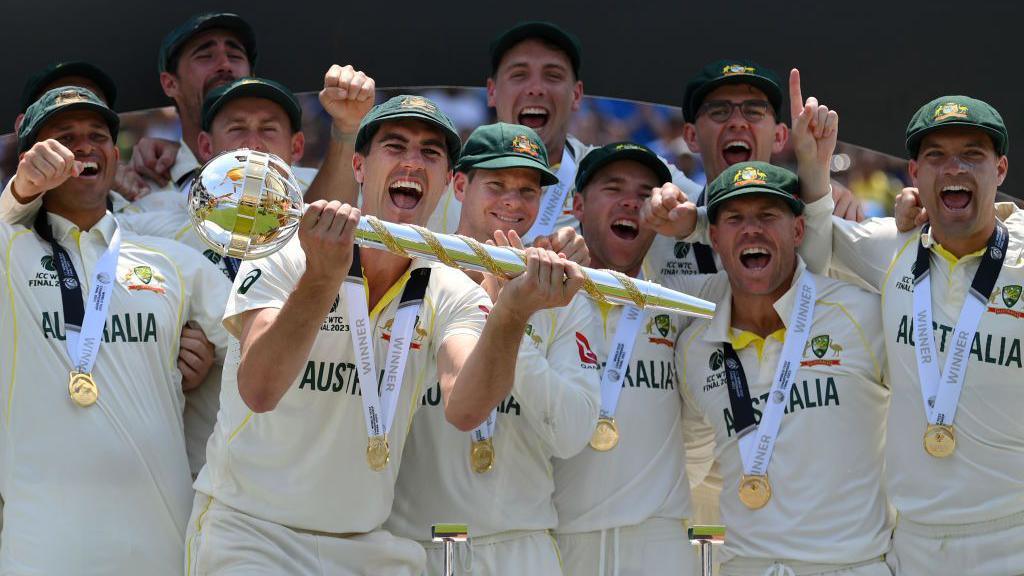The World Test Championship (WTC) is an international cricket competition organized by the International Cricket Council (ICC) to determine the best Test-playing nation in the world. Here’s an overview and history of the championship:
About the World Test Championship
- Purpose:
- The WTC was established to bring more context, competitiveness, and excitement to Test cricket, the longest format of the game.
- It rewards consistency and excellence over a two-year cycle of Test matches between top-ranked teams.
- Format:
- Teams earn points for matches in a league format, culminating in a final between the top two teams.
- Points are awarded based on match results (win, draw, or tie), with an emphasis on winning matches to accumulate points.
- Participants:
- The WTC features the top nine Test-playing nations.
- Each team plays a fixed number of Test series (home and away) during the two-year cycle.
- Final Match:
- The top two teams from the league standings qualify for the WTC Final, held at a neutral venue.
- The winner of the final is crowned the World Test Champion.

History of the World Test Championship
- Background:
- The idea for a championship to crown the best Test team was proposed in the early 2010s.
- It was seen as a way to maintain the relevance of Test cricket in the era of shorter formats like ODIs and T20s.
- Inaugural Edition (2019–2021):
- Cycle: The first WTC began in August 2019 and concluded in June 2021.
- Finalists: New Zealand and India qualified for the final after an intense league stage.
- Winner: New Zealand defeated India by eight wickets in the final held at the Rose Bowl, Southampton, to become the first-ever WTC champions.
- Second Edition (2021–2023):
- Cycle: The second WTC cycle ran from August 2021 to June 2023.
- Finalists: India and Australia emerged as the top two teams.
- Winner: Australia beat India convincingly in the final at The Oval, London, securing their first WTC title.
- Current Cycle (2023–2025):
- The third WTC cycle started in mid-2023 and will culminate in a final in mid-2025.
- Teams continue to compete in home-and-away Test series as part of the league stage.
Significance of the World Test Championship
- Reviving Test Cricket:
- The WTC brings a structured competition to Test cricket, ensuring that every match has stakes.
- It encourages teams to perform consistently over a long period.
- Global Viewership:
- The final attracts global attention, offering a platform for Test cricket to shine in an era dominated by shorter formats.
- Player Motivation:
- Players regard the WTC as a prestigious tournament, often equating it with other ICC trophies like the World Cup.

Key Facts
- First Winner: New Zealand (2021).
- Current Champion: Australia (2023).
- Most Finals Reached: India (two finals, 2021 and 2023).
- Final Venue: The ICC typically chooses iconic cricket grounds in neutral countries (e.g., Rose Bowl, The Oval).
The WTC has established itself as a cornerstone of Test cricket, adding purpose and prestige to bilateral series while celebrating the endurance and skill required for success in the traditional format.
The World Test Championship (WTC) ranking is determined based on a points system and percentage points (PCT) calculation. Here’s a detailed explanation of how the rankings are calculated:
WTC Points System
- Points Per Match:
- Teams earn points for each match played in a WTC series.
- The total points available per series are fixed at 120 points, irrespective of the number of matches.
- Points per match depend on the series length:
- 2-match series: 60 points per win.
- 3-match series: 40 points per win.
- 4-match series: 30 points per win.
- 5-match series: 24 points per win.
- Distribution of Points (Per Match):
- Win: 100% of points for that match (e.g., 12 points in a 5-match series).
- Tie: 50% of points (e.g., 6 points in a 5-match series).
- Draw: 33.33% of points (e.g., 4 points in a 5-match series).
- Loss: 0 points.
- Penalty for Slow Over Rate:
- Teams are docked 1 point for each over they fall short of the required over rate in a match.
Percentage Points (PCT)
The Percentage of Points (PCT) is the primary metric used to rank teams. It represents the percentage of total points a team has earned out of the maximum points available to them.
Formula:
PCT=(Points EarnedPoints Available)×100PCT = \left( \frac{\text{Points Earned}}{\text{Points Available}} \right) \times 100PCT=(Points AvailablePoints Earned)×100
- Points Earned: The total points a team has accumulated.
- Points Available: The maximum points a team could have earned based on matches played.
Example Calculation
Scenario:
- A team plays a 4-match series (30 points per match, total 120 points).
- Results:
- 2 wins: 2×30=602 \times 30 = 602×30=60 points.
- 1 draw: 1×10=101 \times 10 = 101×10=10 points.
- 1 loss: 0×30=00 \times 30 = 00×30=0 points.
- Total Points Earned: 60+10+0=7060 + 10 + 0 = 7060+10+0=70.
- PCT: PCT=(70120)×100=58.33%PCT = \left( \frac{70}{120} \right) \times 100 = 58.33\%PCT=(12070)×100=58.33%
This team would have a PCT of 58.33%, which determines their position in the WTC standings.

WTC Standings
- Rankings are based on the PCT rather than total points. This ensures fairness, as all teams may not play the same number of matches.
- If two teams have the same PCT, the following tiebreakers are used:
- Higher number of series wins.
- Head-to-head results between tied teams.
- ICC Test rankings.
Key Points to Note
- The PCT system ensures fairness, as the number of matches or series varies between teams.
- Teams must focus not only on winning matches but also on avoiding penalties like slow over rates.
- Rankings are dynamic and can change based on ongoing series results.
This system ensures a balanced competition across different teams and series lengths, ultimately rewarding consistent and high-performing teams.
Here are some interesting facts about the ICC World Test Championship (WTC) that cricket fans will enjoy:
1. The First-Ever Test Championship Final Was Affected by Rain
- The inaugural WTC final in 2021 between India and New Zealand faced weather disruptions, with two days completely washed out.
- To accommodate such scenarios, ICC introduced a Reserve Day for the final, which was used for the first time in this match.
2. New Zealand Created History
- New Zealand became the first-ever WTC champion in 2021 by defeating India.
- This victory was particularly special for New Zealand as they had lost two consecutive ODI World Cup finals in 2015 and 2019.
3. Australia Dominated the Second Cycle
- Australia won the 2023 WTC final against India, showcasing their dominance in Test cricket.
- The victory also made Australia the only team to win every ICC tournament format: ODI World Cup, T20 World Cup, Champions Trophy, and now the WTC.
4. A Century by Ross Taylor Sealed the 2021 Final
- In his final ICC tournament appearance, Ross Taylor played a pivotal role by hitting the winning runs in the 2021 final.
- His composure under pressure cemented his legacy as one of New Zealand’s finest Test players.
5. England Hosted Both Finals
- Both WTC finals so far (2021 and 2023) were held in England at iconic venues:
- 2021 Final: The Rose Bowl, Southampton.
- 2023 Final: The Oval, London.
6. India Played in Both Finals but Lost
- India has reached both WTC finals (2021 and 2023) but lost on both occasions.
- This has sparked debates about India’s inability to perform in ICC finals despite being consistent during the league stages.
7. Points Deduction for Over-Rate Violations
- Slow over rates have heavily impacted teams.
- In the second cycle (2021–2023), Australia and India both lost points due to over-rate penalties but still managed to qualify for the final.
8. The WTC Mace
- The winners of the WTC are awarded the Test Championship Mace, which was previously given to the No. 1 Test team in ICC rankings.
9. Players’ Record Performances
- Most Runs (2019–2021 Cycle): Marnus Labuschagne (Australia) scored 1675 runs, the highest in the inaugural cycle.
- Most Wickets (2019–2021 Cycle): Pat Cummins (Australia) took 70 wickets, leading the wicket charts.
10. Impact of the Pandemic on WTC
- The first WTC cycle was heavily disrupted by the COVID-19 pandemic, leading to cancellations of matches and a revised points system.
- The ICC introduced the Percentage Points (PCT) system to rank teams fairly despite the varying number of matches played.
11. Fair Play Rewarded
- New Zealand, known for their sportsmanship, won the inaugural WTC with minimal controversies.
- Their victory highlighted how consistent performance and fair play can lead to success in Test cricket.
12. South Africa’s Missed Opportunity
- In the second cycle (2021–2023), South Africa was a strong contender but missed out on the final due to a string of away losses.
- This underlined the difficulty of winning Test matches in foreign conditions.
13. Significance of Neutral Venues
- The WTC final is always played at a neutral venue, adding a layer of unpredictability.
- This makes it different from most other cricket tournaments where teams play in familiar conditions.
14. Test Cricket’s Revival
- The WTC has brought new life to Test cricket, giving bilateral series more context and stakes.
- Fans now follow the Test format with more interest, especially when matches impact the WTC standings.

Leave a Reply